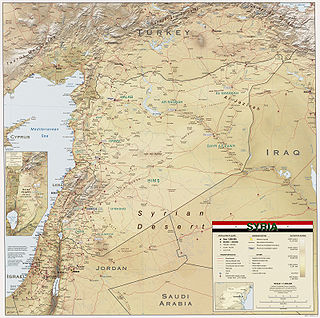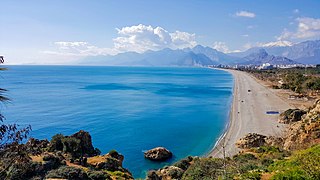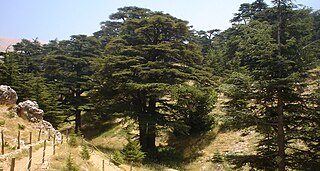
Syria is located in West Asia, north of the Arabian Peninsula, at the eastern end of the Mediterranean Sea. It is bordered by Turkey to the north, Lebanon and Israel to the west and southwest, Iraq to the east, and Jordan to the south. It consists of mountain ranges in the west and a steep area inland. In the east is the Syrian Desert and in the south is the Jabal al-Druze Range. The former is bisected by the Euphrates valley. A dam built in 1973 on the Euphrates created a reservoir named Lake Assad, the largest lake in Syria. The highest point in Syria is Mount Hermon on the Lebanese border at 2,814 metres or 9,232 feet. Between the humid Mediterranean coast and the arid desert regions lies a semiarid steep zone extending across three-quarters of the country, which receives hot, dry winds blowing across the desert. Syria is extensively depleted, with 28 percent of the land arable, 4 percent dedicated to permanent crops, 46 percent utilized as meadows and pastures, and only 3 percent forest and woodland.

Pistacia is a genus of flowering plants in the cashew family, Anacardiaceae. It contains 10 to 20 species that are native to Africa and Eurasia from the Canary Islands, all of Africa, and southern Europe, warm and semidesert areas across Asia, and North America from Guatemala to Mexico, as well as southern Texas.

Sclerophyll is a type of vegetation that is adapted to long periods of dryness and heat. The plants feature hard leaves, short internodes and leaf orientation which is parallel or oblique to direct sunlight. The word comes from the Greek sklēros (hard) and phyllon (leaf). The term was coined by A.F.W. Schimper in 1898, originally as a synonym of xeromorph, but the two words were later differentiated.

Bilad al-Sham, often referred to as Islamic Syria or simply Syria in English-language sources, was a province of the Rashidun, Umayyad, Abbasid, and Fatimid caliphates. It roughly corresponded with the Byzantine Diocese of the East, conquered by the Muslims in 634–647. Under the Umayyads (661–750) Bilad al-Sham was the metropolitan province of the Caliphate and different localities throughout the province served as the seats of the Umayyad caliphs and princes.

Pistacia terebinthus also called the terebinth and the turpentine tree, is a deciduous shrub species of the genus Pistacia, native to the Mediterranean region from the western regions of Morocco and Portugal to Greece and western and southeastern Turkey. At one time terebinths growing on the eastern shores of the Mediterranean Sea were regarded as a separate species, Pistacia palaestina, but these are now considered to be a synonym of P. terebinthus.

In biogeography, the Mediterranean Basin, also known as the Mediterranean Region or sometimes Mediterranea, is the region of lands around the Mediterranean Sea that have mostly a Mediterranean climate, with mild to cool, rainy winters and warm to hot, dry summers, which supports characteristic Mediterranean forests, woodlands, and scrub vegetation. It was a very important part of Mediterranean civilizations.

The Eastern Mediterranean conifer-sclerophyllous-forests, also known as the Eastern Mediterranean conifer-forests, is an ecoregion in the eastern Mediterranean Basin. It covers portions of Turkey, Syria, Iraq, Lebanon, Israel, Palestinian territories, Jordan, and Saudi Arabia.

The Mediterranean Region is a geographical region of Turkey. The largest city in the region is Antalya. Other big cities are Adana, Mersin, Isparta, Antakya and Kahramanmaraş.

The Asian garden dormouse or large-eared garden dormouse, is a species of rodent in the family Gliridae. It is found in Egypt, Iraq, Israel, Jordan, Lebanon, Libya, Saudi Arabia, Syria and Turkey. Its natural habitats are temperate forests, subtropical or tropical dry shrubland, Mediterranean-type shrubby vegetation, rocky areas and gardens.

The wildlife of Morocco is composed of its flora and fauna. The country has a wide range of terrains and climate types and a correspondingly large diversity of plants and animals. The coastal areas have a Mediterranean climate and vegetation while inland the Atlas Mountains is forested. Further south, the borders of the Sahara Desert are increasingly arid. Large mammals are not particularly abundant in Morocco, but rodents, bats, and other small mammals are more plentiful. Four hundred and ninety species of birds have been recorded here.

Asphodeline is a genus of perennial plants in the family Asphodelaceae, first described as a genus in 1830. It is native to the eastern Mediterranean region and the Middle East from Italy and Algeria east to Iran.

As of 2000 about 9300 species of vascular plant were known to grow in Turkey. By comparison, Europe as a whole contains only about 24% more species, despite having thirteen times the area.
The wildlife of Turkey is abundant and diverse. Turkey is a large country with many geographic and climatic regions and a great diversity of plants and animals, each suited to its own particular habitat. About 1,500 species of vertebrates and 19,000 species of invertebrates have been recorded in the country. Some of the world's staple crops were first cultivated in this area and many of their wild relatives are still found here. The country acts as a crossroads for many birds during migration, connecting Europe, Asia, and the Near East.

The Southern Anatolian montane conifer and deciduous forests ecoregion, in the Mediterranean forests, woodlands, and scrub biome, is in the eastern Mediterranean Basin.
The wildlife of Lebanon refers to the flora and fauna of Lebanon, a country in Asia located at the eastern end of the Mediterranean Sea. The country has four main geographical areas: the coastal plain, Mount Lebanon, the Beqaa Valley and the Anti-Lebanon Mountains. The climate is Mediterranean, with the coastal regions experiencing hot, humid summers and cool, wet winters, and the elevated areas inland experiencing colder winters with snow that lingers on into the summer. The country offers a variety of habitats for wildlife, including mountains, valleys, marshes, coastal plains, salt marshes and sea coasts.

Caroxylon vermiculatum, commonly known as Mediterranean saltwort, is a perennial plant in the family Amaranthaceae. It has many synonyms, including Salsola vermiculata and Nitrosalsola vermiculata. It is native to arid and semi-arid regions of the Middle East, North Africa and southern Europe where it is used as a fodder plant for livestock.

The wildlife of Spain includes the diverse flora and fauna of Spain. The country located at the south of France has two long coastlines, one on the north on the Cantabrian Sea, another on the East and South East on the Mediterranean Sea, and a smaller one on the west and south west on the Atlantic Ocean, its territory includes a big part of the Iberian Peninsula, the Canary Islands, the Balearic Islands and two enclaves in North Africa, Ceuta and Melilla. and the different climate zones, Spain is one of the countries in Europe with the greatest biodiversity.

The wildlife of Greece includes the diverse flora, fauna, and funga of Greece, a country in southern Europe. The country is mostly mountainous with a very long, convoluted coastline, consisting of peninsulas and many islands. The climate ranges from Mediterranean through temperate to alpine, and the habitats include mountains, hills, forests, rivers, lakes, coasts and cultivated land.


















